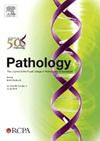残存的增生性肿瘤负担能否预测乳腺癌新辅助化疗后的长期预后?
IF 3
3区 医学
Q1 PATHOLOGY
引用次数: 0
摘要
残留增生性肿瘤负担(RPCB)已被认为是乳腺癌接受新辅助化疗(NACT)的长期预后的一个强有力的预测模型。在我们的研究中,我们的目的是比较多种后nact分类评估残留疾病的预后价值。对97例行NACT手术的原发性乳腺癌患者的手术标本进行残留癌负荷(RCB)评估。应用免疫组织化学方法对术后残留病变的手术切除标本进行Ki-67增殖指数定量分析。然后,我们将解剖RCB指数与治疗后生物学Ki-67结合使用各参数的Cox比例风险模型计算RPCB评分。Kaplan-Meier法显示,RCBIII预后不良,无复发生存期(RFS)较RCBI差(估计5年RFS率为38%),而RCBI的预后与病理完全缓解(等于RCB0)相似(估计5年RFS率分别为80%和100%)(p=0.012)。RCBII显示中等预后(估计5年RFS率为79%)。较高的nact后Ki-67(高于临界值20%)对总生存期和RFS有负面影响(p本文章由计算机程序翻译,如有差异,请以英文原文为准。
Can residual proliferative cancer burden predict long-term outcomes following neoadjuvant chemotherapy in breast cancer?
Residual proliferative cancer burden (RPCB) has been suggested as a strong predictor model of long-term outcomes in breast cancer undergoing neoadjuvant chemotherapy (NACT). In our study, we aimed to compare the prognostic value of multiple post-NACT classifications for assessing residual disease. Archival surgical specimens of 97 patients with primary breast cancer who underwent NACT were evaluated for residual cancer burden (RCB). The post-operative Ki-67 proliferation index was quantified using immunohistochemistry on post-treatment surgical excision specimens with residual disease. Then, we calculated the RPCB scores by combining the anatomical RCB index with the biological post-therapeutic Ki-67 using the Cox proportional hazard model for each parameter. Using the Kaplan–Meier method, RCBIII showed an unfavourable prognosis with worse relapse-free survival (RFS) (estimated 5-year RFS rate of 38%) than RCBI, which displayed a similarly good prognosis as pathological complete response (equal to RCB0) (estimated 5-year RFS rates of 80% and 100%, respectively) (p=0.012). The RCBII showed an intermediate prognosis (estimated 5-year RFS rate of 79%). A higher post-NACT Ki-67 (greater than cut-off 20%) had a negative impact on the overall survival and RFS (p<0.0001 for both) using the Kaplan–Meier method. In multivariate analysis, the histological residual tumour size, number of affected lymph nodes, and RCB index remained independent prognostic factors for RFS. In addition, RPCBIII showed the worst prognosis (with an estimated 5-year RFS rate of 38%) compared to RPCBI (estimated 5-year RFS rate of 83%) (p=0.039) by the Kaplan–Meier method. The area under the curve of the RCB index was 0.82 compared to 0.62 for the RPCB model in terms of RFS prediction. Our study highlighted the potential stratification of RCBII cases based on the RPCB classification. Further studies with larger cohorts will be needed to validate whether the RCPB adds value to residual disease assessment.
求助全文
通过发布文献求助,成功后即可免费获取论文全文。
去求助
来源期刊

Pathology
医学-病理学
CiteScore
6.50
自引率
2.20%
发文量
459
审稿时长
54 days
期刊介绍:
Published by Elsevier from 2016
Pathology is the official journal of the Royal College of Pathologists of Australasia (RCPA). It is committed to publishing peer-reviewed, original articles related to the science of pathology in its broadest sense, including anatomical pathology, chemical pathology and biochemistry, cytopathology, experimental pathology, forensic pathology and morbid anatomy, genetics, haematology, immunology and immunopathology, microbiology and molecular pathology.
 求助内容:
求助内容: 应助结果提醒方式:
应助结果提醒方式:


